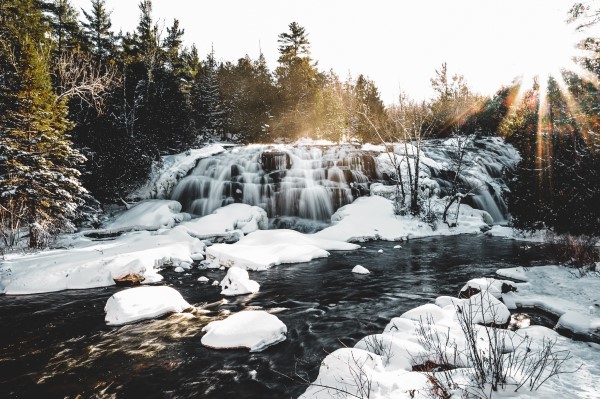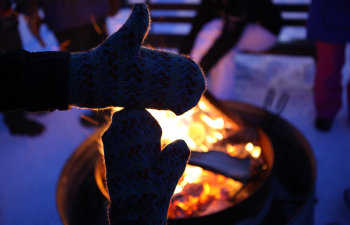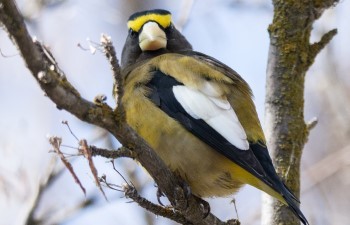|
Here are just a few of this week's stories from the Michigan Department of Natural Resources:
See other news releases, Showcasing the DNR stories, photos and other resources at Michigan.gov/DNRPressRoom.
PHOTO FOLDER: Larger, higher-res versions of the images used below, and others, are available in this folder.
 Want to see more pictures like this, taken by Michigan state parks photo ambassador Samantha Hageman Gaina at the Bond Falls Scenic Site in Ontonogan County? Visit Instagram.com/MiStateParks to explore photos and learn more about the photo ambassadors! For more on the photo ambassador program, call Stephanie Yancer at 989-274-6182.

Snowball fights with siblings and friends. A backyard treehouse. Ice fishing with grandpa. Spying bright birds in fresh snow. Wintry hikes at the local park. Long walks in the woods. Even just a well-placed window with a view that ignited your outdoor dreams ...
No matter where you're from or where you call home, everyone has a story about the outdoors. Each perspective is unique and every story is different, and we want to help share them with our quarterly Gather 'Round blog: an online space to hear signature stories written by people like you, along with looks at little-known critters, places, Michigan history and more.
The winter issue covers topics like falconry in Michigan and a recipe for a venison pot roast, easy ways to engage with nature and history, and a segment called wilderness wisdom 101, a guide to winter recreation for newbies. If you like what you see, feel free to share Gather 'Round with your friends and family.
Questions? Contact Emma Kukuk.
|

As winter begins across Michigan, bird-watchers are eagerly awaiting the arrival of winter finches, which are moving in large numbers outside their typical range.
The latest winter finch forecast from the Finch Research Network predicted purple finches, common and hoary redpolls, pine siskins and evening grosbeaks would be on the move this year. Michigan might also see pine grosbeaks, red crossbills and white-winged crossbills.
These birds depend on the cone and berry crops of the boreal (Earth’s northernmost) forest for food each winter. When there is not enough food, they will migrate outside of their usual wintering grounds. This unusual migratory movement is called an irruption, which will bring northern finches south into lower Ontario, the Great Lakes and beyond. Irruptions don't happen every year, which makes winter finch sightings this year particularly magical.
Learn how to identify and where to find a few of these winter gems:
Purple finch
A small finch, its males have a raspberry-red head, breast and back. Females have thickly streaked undersides, with a whitish eyebrow and dark line down the side of the throat.
Find them in wooded and semi-open areas, including forests, suburbs, swamps and overgrown fields.
Pine siskin
This bird behaves like a goldfinch but is brown and streaked like a sparrow. It has a sharp, pointed bill and subtle yellow edges on its wing and tail feathers.
Find them in semi-open areas, woodland edges and weedy fields.
Evening grosbeak
Colorful, chunky and large-billed, males are yellow and black with a bold white patch in the wing. Females are mostly gray with a yellow wash on the neck and white and black wings.
Find them in noisy flocks at bird feeders and in box elders, maples, woodlands and fruiting shrubs.
Learn about Michigan’s suite of winter finches and how to attract them to your space by visiting the MI Birds webpage.
Questions? Contact Erin Ford at 313-820-0809.
|

Winter brings a burst of activity to Michigan’s backyard bird feeders, with colorful visits from blue jays, northern cardinals and black-capped chickadees – just to name a few! Bird feeders can help attract birds to your space during the winter, when natural food sources could be buried beneath snow or limited in supply. However, when birds congregate at feeders, it can sometimes make it easier for diseases to spread among them.
This fall, we recommended that backyard bird feeders be removed due to the highly pathogenic avian influenza outbreak that affected waterfowl, raptors, scavengers, gulls and terns. While most of these bird species do not frequently visit neighborhood bird feeders, follow these tips to continue to keep birds safe this season:
-
The more you can do to discourage the artificial gathering of birds during this outbreak, the better. While removal of bird feeders is not mandatory – and songbirds are generally a lower risk group – it is recommended that bird feeders be taken down during fall migrations out of an abundance of caution. Fall migrations for most birds end around late fall or early winter. It should be safer to put out bird feeders this winter, particularly once your local waters freeze over.
-
Cleaning bird feeders every two weeks with a 1-to-10 bleach to water solution (10% bleach) is always good practice. Cleaning bird feeders regularly will help prevent transmission of HPAI and other diseases. Scrub away any debris and dry the feeder before refilling. Clean bird baths with a scrub brush in a solution of nine parts water and one part vinegar.
For more information about HPAI in your county, and to stay up to date on the latest recommendations from the DNR, visit the avian influenza updates webpage or explore the HPAI FAQ page.
If you live in an area where deer are also common backyard visitors, check out our recommendations on how to prevent deer from gathering around your bird feeders.
To learn more about Michigan’s birds, visit the MI Birds webpage.
Questions? Contact Erin Ford at 313-820-0809.
|

Recommendations on whether to keep, exchange or sell state-managed land in 11 counties are nearing DNR director approval, but there’s still plenty of time to review and share feedback.
The counties in this stage of the DNR's ongoing state land review process include Alger, Allegan, Barry, Bay, Gladwin, Lake, Midland, Montmorency, Presque Isle, Schoolcraft and Wexford.
The updated, interactive web map reflects the latest staff recommendations since the initial public comment period closed, making it easy for people to see what has changed. The state land review was implemented as part of the 2013 Managed Public Land Strategy; during review, staff evaluates DNR-managed lands that are 200 acres or less in size or that, due to an irregular boundary, may be difficult to manage.
“This county-by-county review process gives us the opportunity to evaluate and make decisions about how well the current land portfolio supports our mission of protecting natural resources while providing broad public access to quality outdoor recreation opportunities,” said DNR forest land administrator Kerry Heckman. “It’s critical that people who enjoy and use these lands are part of the discussion, and we appreciate everyone who has taken the time to get involved so far.”
Comments left on the interactive web map or emailed to DNR-StateLandReview@Michigan.gov by Feb. 8 will be compiled and provided to the DNR director. A final decision on recommendations is expected at the Feb. 9 meeting of the Michigan Natural Resources Commission.
For the latest on the state land review process, visit Michigan.gov/PublicLands or contact Scott Whitcomb at 231-373-3007.
|
|